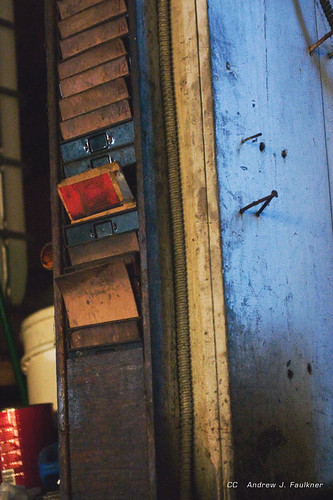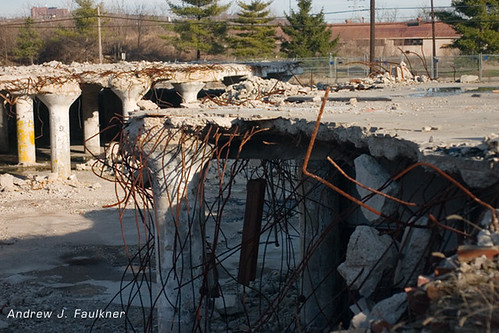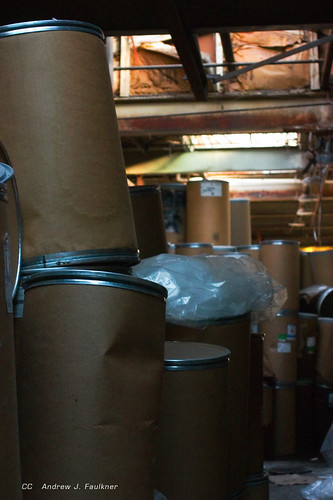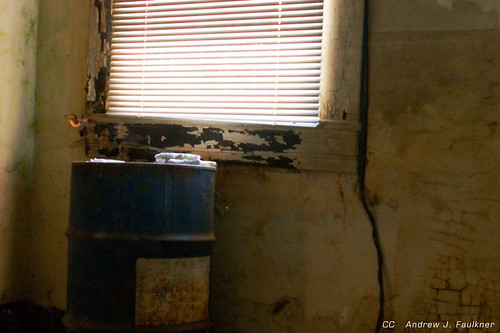It is relatively easy to pass by or through a specific place without fully comprehending the implications of the place on overarching patterns of urbanism or conversely the reflections of larger social and cultural patterns within everyday spaces. In this essay I seek to establish the specific site of St. Louis's Union Station in its current state as both a reflection of larger attitudes to urbanism and a destabilizing force on surrounding areas.
Union Station is a surprisingly late manifestation of the Victorian unease between tradition and rapidly changing technology. Like much earlier examples such as London's St. Pancras Station Union Station consists of a thin street building built in an overly traditional vocabulary (in this case halfway between Richardsonian Romanesque and French Chateau) which disguises a steel framed trainshed from public view. That the stone terminal building was built in St. Louis during the same decade as three muscular modern skyscrapers by Louis Sullivan points to a continuous thread of conservatism which continues to dominate the built environment here to this day.
At the time of its construction the 11 acre trainshed was one of the largest in the world and served a peak of 100,000 passengers a day. Fast forward a half century. The process of urbanization has become internalized. Physical urbanization is no longer necessary as increased communication allows connection by proxy and urban space has been supplanted by a decentralized urban society [see Henri Lefebvre, The Urban Revolution] As physical proximity becomes unimportant and speed of travel increases de-densification increases and the confined vectors of rail transit become less effective; combined with the well documented collusion of government and the auto industry transit and rail foundered. The station officially was mothballed in 1978.
The phenomena of suburbanization and disinvestment in urban areas is also deeply rooted in American culture. In some ways the migration to the suburbs was the technologically aided fulfillment of the dream of Jeffersonian Democracy. As Witold Rybczynski quotes de Tocqueville "The spirit of equality has stamped a particularly uniform pattern on the habits of private life" (Rybczynski, 112.) Rybczynski interprets this as evidence of the United States having the first equally distributed urban society. Unlike Europe there has never been a sharp delineation between sophistication (urban) and rusticity (rural) rather the whole culture falls on a reasonably level ground between the two. Given this proposition (if culture is urbanized urbanization becomes to an extent superfluous) and the rootlessness of the American people (refer to Frederick Jackson Turner's Frontier Thesis) it is reasonable to conclude that the speculative and impermanent nature of the American city is a direct result. As Lefebvre notes "Urban democracy would imply an equality of places" while the traditional urban concept of "centrality would produce hierarchy and therefore inequality" (Lefebvre, 124). Of course the enduring paradox is that once the undemocratic hierarchy of the city is broken through decentralization segregation (economic, racial, ethnic, and social) is the inevitable undemocratic result.
To be continued...
Part I Bibliography:
Lefebvre, Henri. The Urban Revolution. Minneapolis: the University of
Minnesota Press, 2003.
Rybczynski, Witold. City Life: Urban Expectations in a New World. New York:
Scribner, 1995.
Urbanist Zeitgeist: St. Louis Union Station Part I
Posted by
Andrew J. Faulkner
on 6.02.2007
Posted in:
architecture,
Feature,
history,
Saint Louis,
Urbanism
/
Comments: (0)
Only A Pawn in Their Game...
Posted by
Andrew J. Faulkner
on 1.26.2007
Posted in:
cincinnati,
exploitation,
Feature,
neo-liberalism,
post-fordism,
Urbanism
/
Comments: (0)
A few weeks ago I found myself standing in Cincinnati; I was in the company of several other explorers, historians, and photographers seeking out subjects in the grimy industrial valley extending northwest from the Ohio River and downtown. Home to an enormous rail yard, rail terminal turned museum, and an impressive density of outmoded, derelict, and undervalued industries, the Mill Creek valley is notable for raw sewage releases from the overtaxed municipal sewage treatment plant. A series of impressive concrete and steel viaducts traverse the railyards and creek and it has been said that the gloomy and almost gothic expressionism of the 8th Street viaduct inspired set designers for Batman Returns.
On either side of the viaduct are dozens of small factories and warehouses that, having been abandoned by their original proprietors, have been amalgamated into the sprawling Lower Price Hill complex of the Queen City Barrel Company. Queen City recycles the eponymous 55 gallon drums whether steel, aluminum, cardboard, or plastic. Plastic and paper drums are shredded (uncleaned) and sold back as raw material and metal drums are placed in an incinerator to flare off the content before being sanded and repainted. (This might be the only case of recycling being less ecological than disposal!) Due to the undesirable nature of the work, excepting the management, the workforce is in entirety composed of Mexicans of dubious legality. In 2004 a large building containing stored drums burst into flames and the resulting massive fire and pollution plume forced large evacuations suspiciously only hours after the company sold the land to the city....
During my visit I observed a huge jumble of drums in the building immediately adjacent to the viaduct piled to the ceiling and in danger of collapse. These drums had formerly contained both ammonium tetrachloride and pre-made salsa mix. The city of Cincinnati has purchased the entire complex for redevelopment and Queen City's tenure will allegedly only extend until April. The second building I shot in was supposed to be completely vacant, yet contained several palettes of mysterious aluminum drums labeled in Japanese. At this point it became clear that despite numerous agreements the company was at least engaged in covert action in blatant violation of their promises to vacate if not more serious crimes with the suspicious fire a year before.
The complex is spread piecemeal among dozens of former manufacturing facilities spread on either side of the viaduct and we continued on to a building that was formerly a knife factory. It was a double height space again stacked to the ceiling with blue barrels in a rambling maze-like pattern. In the back a gang of Mexicans was disposing the barrels in a large shredder. As we stepped in we knew something was different. Before I got a photo off my throat began to burn. I put on my p-100 respirator. Even that did not seem to help matters and in the end I never got more than ten feet in from the sidewalk. But then again the owner has assured reporters that the company fulfills federal standards so we should have all just breathed easy. In any case we quickly left and I still find myself thinking about those poor Mexican laborers working without respirators in those conditions for 10 or 12 hours a day. But for the owners it is cheaper and easier to just dispose of the workers when they inevitably develop debilitating respiratory conditions rather than even attempting to make the minor outlay to look after their well-being. In a country with our abundant wealth such actions are not only incredibly immoral, they hint at a pervasive corrosiveness undermining our supposedly cherished principles of life and liberty.
Up the street is the incinerator which again is supposed lie cold; however the palettes of shiny barrels awaiting paint and dirty barrels awaiting flaming belie the clandestine night burnings Queen City still engages in. Such is life in Cincinnati: the government ignores industrial transgressions and puts business profits ahead of the health and well-being of its residents. This echoes a common story from twenty years ago when Proctor and Gamble blatantly continued to fire excess chemicals off in their incinerator down the street for nearly a decade after being ordered to cease; somehow no one with authority managed to connect the noxious haze the settled every morning at dawn over the entire valley with the region's largest employer.
So the next time some silver spoon-fed pundit or hack politician suggests that we should deport the Mexicans and build that ludicrous wall because there are plenty of Americans who would gladly reclaim their jobs, just remember the poor workers at Queen City Barrel and countless other such businesses whose very lives are being sacrificed at the altar of insignificant overhead. Many of them may not live long enough to see their families join them or their children make a better life than they have done.
The American dream of course only applies to its official citizens -- and then only the politically connected ones.
On either side of the viaduct are dozens of small factories and warehouses that, having been abandoned by their original proprietors, have been amalgamated into the sprawling Lower Price Hill complex of the Queen City Barrel Company. Queen City recycles the eponymous 55 gallon drums whether steel, aluminum, cardboard, or plastic. Plastic and paper drums are shredded (uncleaned) and sold back as raw material and metal drums are placed in an incinerator to flare off the content before being sanded and repainted. (This might be the only case of recycling being less ecological than disposal!) Due to the undesirable nature of the work, excepting the management, the workforce is in entirety composed of Mexicans of dubious legality. In 2004 a large building containing stored drums burst into flames and the resulting massive fire and pollution plume forced large evacuations suspiciously only hours after the company sold the land to the city....
During my visit I observed a huge jumble of drums in the building immediately adjacent to the viaduct piled to the ceiling and in danger of collapse. These drums had formerly contained both ammonium tetrachloride and pre-made salsa mix. The city of Cincinnati has purchased the entire complex for redevelopment and Queen City's tenure will allegedly only extend until April. The second building I shot in was supposed to be completely vacant, yet contained several palettes of mysterious aluminum drums labeled in Japanese. At this point it became clear that despite numerous agreements the company was at least engaged in covert action in blatant violation of their promises to vacate if not more serious crimes with the suspicious fire a year before.
The complex is spread piecemeal among dozens of former manufacturing facilities spread on either side of the viaduct and we continued on to a building that was formerly a knife factory. It was a double height space again stacked to the ceiling with blue barrels in a rambling maze-like pattern. In the back a gang of Mexicans was disposing the barrels in a large shredder. As we stepped in we knew something was different. Before I got a photo off my throat began to burn. I put on my p-100 respirator. Even that did not seem to help matters and in the end I never got more than ten feet in from the sidewalk. But then again the owner has assured reporters that the company fulfills federal standards so we should have all just breathed easy. In any case we quickly left and I still find myself thinking about those poor Mexican laborers working without respirators in those conditions for 10 or 12 hours a day. But for the owners it is cheaper and easier to just dispose of the workers when they inevitably develop debilitating respiratory conditions rather than even attempting to make the minor outlay to look after their well-being. In a country with our abundant wealth such actions are not only incredibly immoral, they hint at a pervasive corrosiveness undermining our supposedly cherished principles of life and liberty.
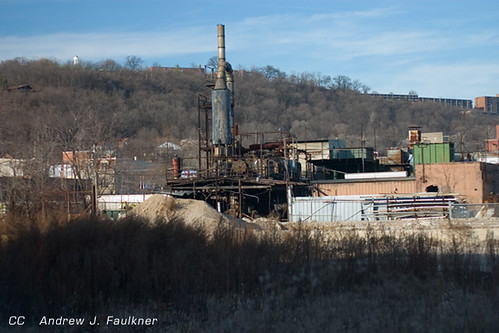
(Allegedly Mothballed Incinerator)
Up the street is the incinerator which again is supposed lie cold; however the palettes of shiny barrels awaiting paint and dirty barrels awaiting flaming belie the clandestine night burnings Queen City still engages in. Such is life in Cincinnati: the government ignores industrial transgressions and puts business profits ahead of the health and well-being of its residents. This echoes a common story from twenty years ago when Proctor and Gamble blatantly continued to fire excess chemicals off in their incinerator down the street for nearly a decade after being ordered to cease; somehow no one with authority managed to connect the noxious haze the settled every morning at dawn over the entire valley with the region's largest employer.
So the next time some silver spoon-fed pundit or hack politician suggests that we should deport the Mexicans and build that ludicrous wall because there are plenty of Americans who would gladly reclaim their jobs, just remember the poor workers at Queen City Barrel and countless other such businesses whose very lives are being sacrificed at the altar of insignificant overhead. Many of them may not live long enough to see their families join them or their children make a better life than they have done.
The American dream of course only applies to its official citizens -- and then only the politically connected ones.
On Modernity (and lousy furniture design)...
Posted by
Andrew J. Faulkner
on 1.18.2007
Posted in:
reflection
/
Comments: (0)
This really is unrelated, but I feel obligated to share this personal story.
This morning as I pulled on my jeans (two legs at a time like all great men) I realized my pocket seemed a little light. Wallet? Check. Pen? Check. Cellphone? Cellphone!? Fortunately this happened on the day I don't have class until 4:00pm so I did have the luxury of time to search. After turning my apartment inside out (which was a mean feat given that all of my studio supplies are here until I move them back to school tomorrow) I began running over the alternatives in my head. I hadn't used the phone for two days so it could have been left at the library or in Givens Hall or at the community center in The Ville (see yesterday's post) or worst of all on the metro bus. I visited both the library and Givens and checked their respective lost and founds... nada.
I came back home and remembered I took the trash out so I dutifully dug through kitchen garbage just in case... nope. All the while I was thinking if I just had a roommate who could call the phone while I walked around looking for it; such are the joys of living alone, but then again no one eats your food either.
Finally I remembered you can send text messages from your phone on the t-mobile website. I fired one off and heard a glorious beep... somewhere in my 743 sf apartment. So armed with a maglight and the laptop I stalked around the apartment playing a high tech version of hot and cold for an eternity. Wasn't modern technology supposed to change us for the better not make life more complicated in the same routine?
For the record the phone was hiding inside the recliner. It is a recliner that has an internal mechanism that drops the back and kicks out the footrest (one of my sweetest pieces of free furniture ever) and on the left side (only!?) a metal rail serves to catch anything that slips through the cracks. I had even picked up and moved the damn thing twice... if any furniture designers are listening please make sure stuff doesn't fall or drops straight through on everything; after all beauty is a byproduct of intelligent function.
In other news I got into John Hoal's studio so I will be using New Orleans as the site for several urban design projects.
This morning as I pulled on my jeans (two legs at a time like all great men) I realized my pocket seemed a little light. Wallet? Check. Pen? Check. Cellphone? Cellphone!? Fortunately this happened on the day I don't have class until 4:00pm so I did have the luxury of time to search. After turning my apartment inside out (which was a mean feat given that all of my studio supplies are here until I move them back to school tomorrow) I began running over the alternatives in my head. I hadn't used the phone for two days so it could have been left at the library or in Givens Hall or at the community center in The Ville (see yesterday's post) or worst of all on the metro bus. I visited both the library and Givens and checked their respective lost and founds... nada.
I came back home and remembered I took the trash out so I dutifully dug through kitchen garbage just in case... nope. All the while I was thinking if I just had a roommate who could call the phone while I walked around looking for it; such are the joys of living alone, but then again no one eats your food either.
Finally I remembered you can send text messages from your phone on the t-mobile website. I fired one off and heard a glorious beep... somewhere in my 743 sf apartment. So armed with a maglight and the laptop I stalked around the apartment playing a high tech version of hot and cold for an eternity. Wasn't modern technology supposed to change us for the better not make life more complicated in the same routine?
For the record the phone was hiding inside the recliner. It is a recliner that has an internal mechanism that drops the back and kicks out the footrest (one of my sweetest pieces of free furniture ever) and on the left side (only!?) a metal rail serves to catch anything that slips through the cracks. I had even picked up and moved the damn thing twice... if any furniture designers are listening please make sure stuff doesn't fall or drops straight through on everything; after all beauty is a byproduct of intelligent function.
In other news I got into John Hoal's studio so I will be using New Orleans as the site for several urban design projects.
...And We're Back
Posted by
Andrew J. Faulkner
on 1.17.2007
/
Comments: (0)
Well I must confess to being particularly derelict regarding the blog. I've actually been working behind the scenes on a feature story (to debut soon) which is a new development given that my previous posts have basically been written off of the top of my head. I had an internet-free vacation at my parents house for Christmas, but instead of resting went all out on photography logging almost 700 images in locations from Columbus to Cincinnati to New Jersey. You can see some of the goodness on my flickr photo pool or just wait for future installments of FOTOFriday. As a result of all that effort once I made my way back to St. Louis I became entirely worthless for about 5 days other than eating and sleeping copiously.
I have always been a person who does not mind expending any amount of effort for an interesting or noble cause I can believe in and this semester at Wash U. seems to do just that. Whether because of Dean Lindsay's social outlook as pertaining to architecture (which this campaigner applauds heartily) or simply because of the alignment of the stars, I have been lucky enough to once again dabble academically in both issues of shrinking cities/abandonment and in community-based design and development; the first with Gia Daskalakis in a seminar examining the convergence of landscape architecture and urbanism and the second in a seminar involving the design of a community market in the historic African American neighborhood of The Ville. I should find out my option studio assignment tomorrow and that has the potential to either sweeten or balance the package, but it is looking up so far as compared to last semester.
I have always been a person who does not mind expending any amount of effort for an interesting or noble cause I can believe in and this semester at Wash U. seems to do just that. Whether because of Dean Lindsay's social outlook as pertaining to architecture (which this campaigner applauds heartily) or simply because of the alignment of the stars, I have been lucky enough to once again dabble academically in both issues of shrinking cities/abandonment and in community-based design and development; the first with Gia Daskalakis in a seminar examining the convergence of landscape architecture and urbanism and the second in a seminar involving the design of a community market in the historic African American neighborhood of The Ville. I should find out my option studio assignment tomorrow and that has the potential to either sweeten or balance the package, but it is looking up so far as compared to last semester.

